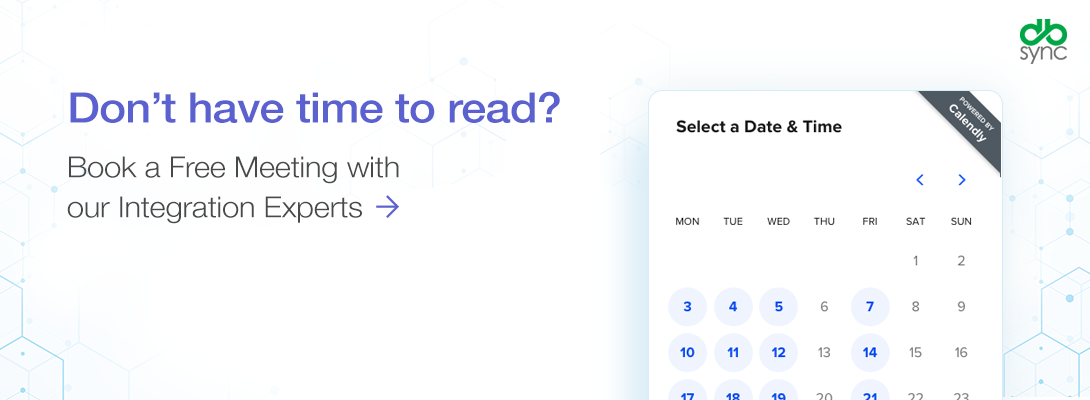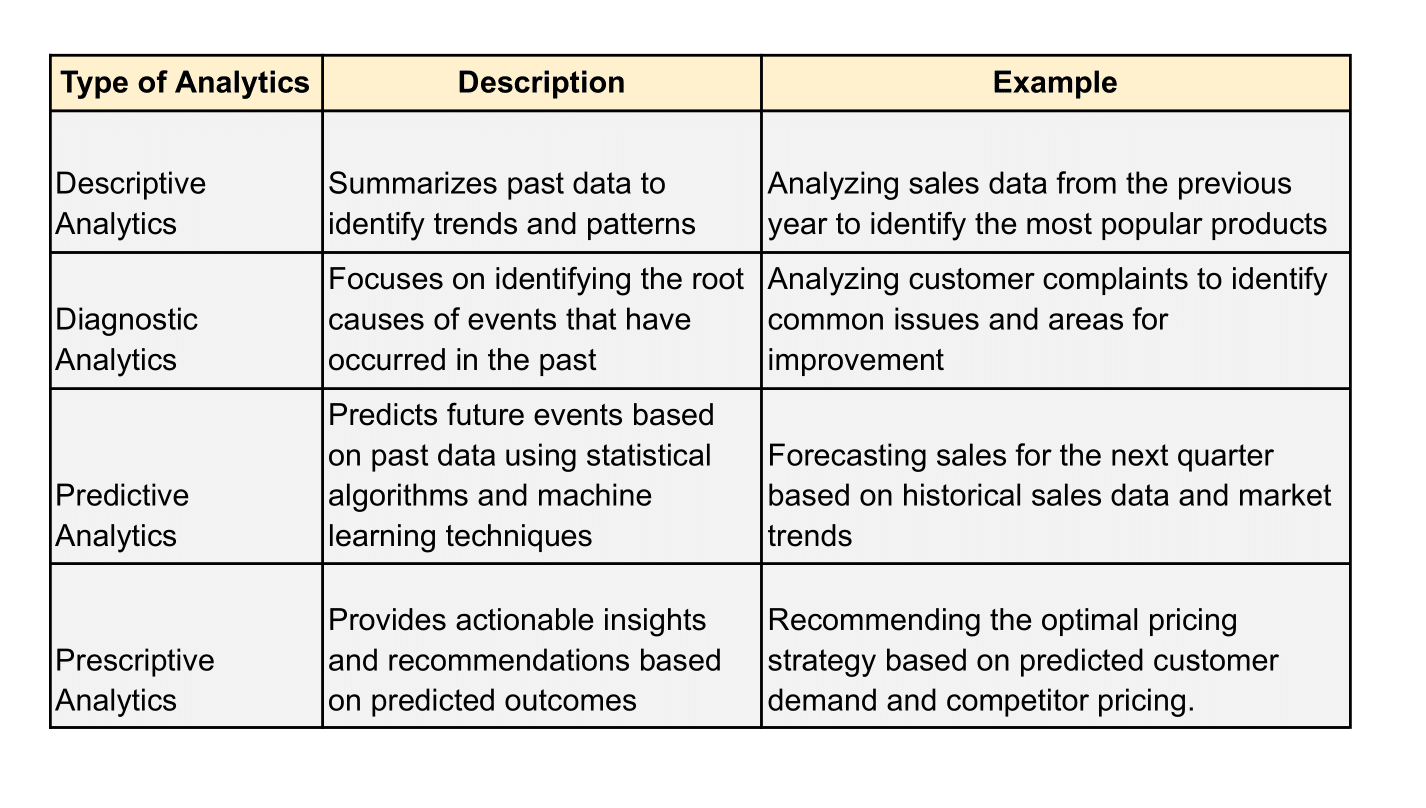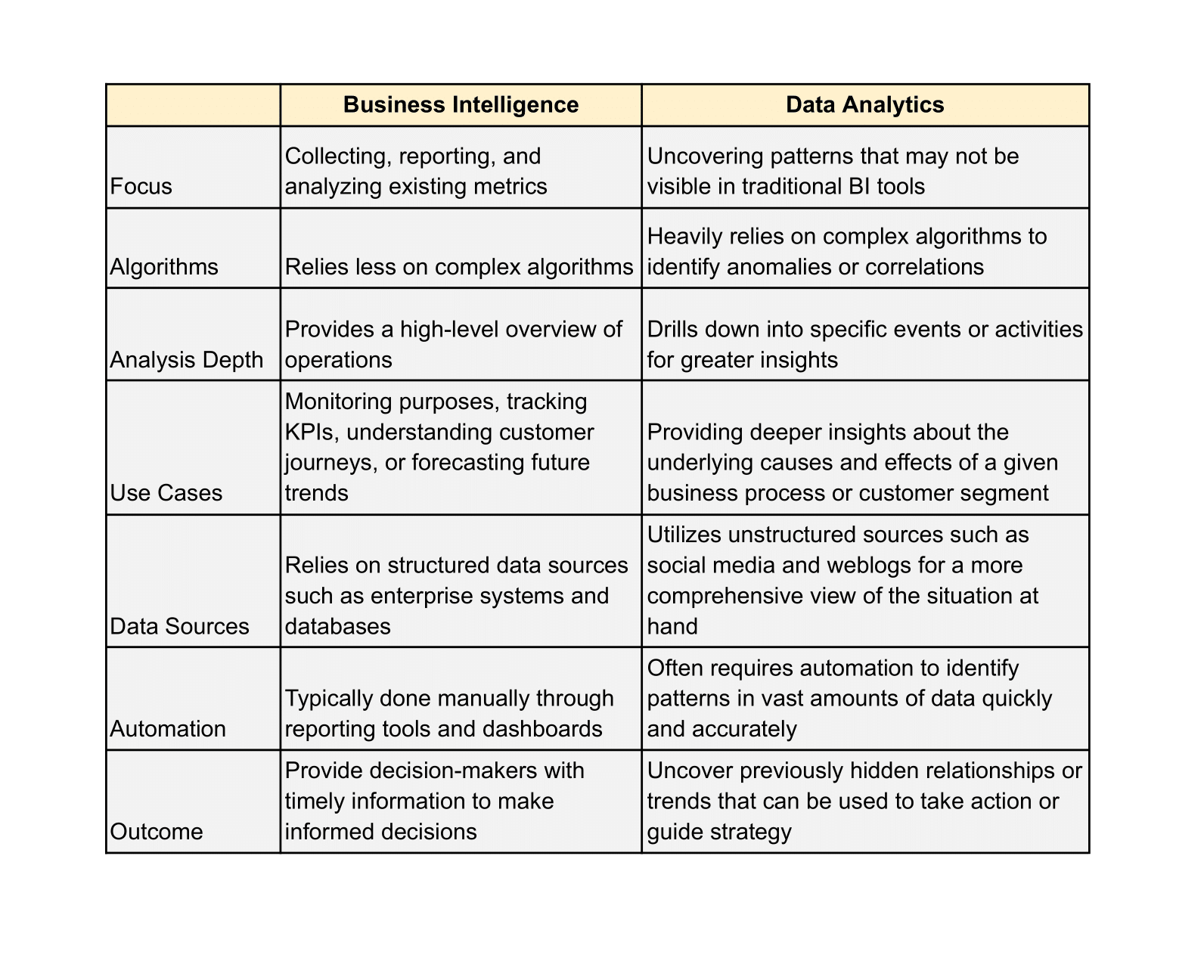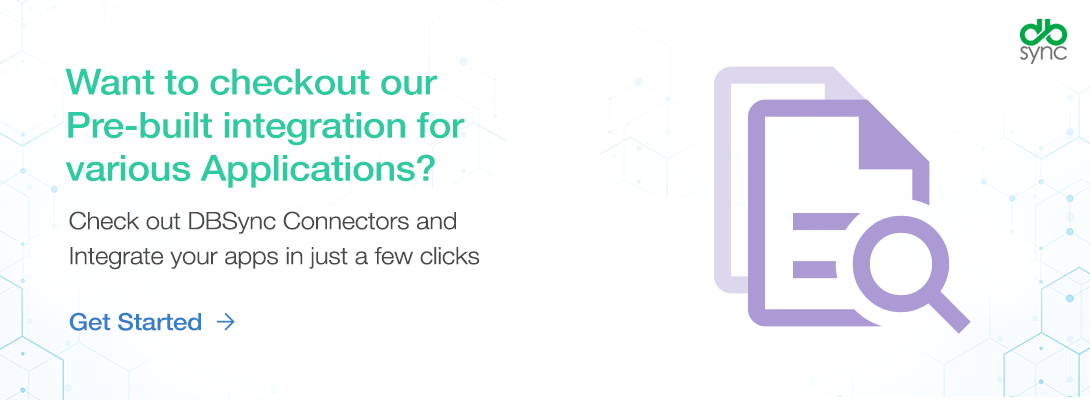Business Intelligence vs. Data Analytics
Do you want to stay ahead of the competition or want reliable ways to make better data-driven decisions in your business that will help promote long-term success? Then, understanding the critical differences between business intelligence and data analytics is essential.
While BI and data analytics may seem similar at first glance, they each bring unique advantages to optimizing a company’s operations.
In this blog post, we’ll discuss what these two technologies are all about, how they compare, and their implications for business professionals. By equipping yourself with robust knowledge about these topics, you can develop more efficient strategies for gathering information and leverage helpful insights from existing datasets.

Business Intelligence and Data Analytics.
In today’s data-driven business landscape, organizations generate a staggering amount of data daily. Leveraging this data to extract meaningful insights and make informed decisions is imperative to remain competitive and profitable. This is where business intelligence (BI) and data analytics come into play.
BI, business analytics, and data analytics are all robust data management solutions that help companies comprehend historical and contemporary data, derive insights, and make data-driven decisions. Yet, despite their resemblances, the differences between these three solutions should be more frequently considered and understood.
The terms “business intelligence” (BI) and “data analytics” are often confused and, at times, are used interchangeably, even though they are not the same thing.
What sets these solutions apart, and which suits your business requirements? The differences between BI, data analytics, and business analytics could be more apparent, and to add to the confusion, these terms are frequently used in place of one another. To avoid misunderstandings, let us define each of these terms.
What Is Business Intelligence?
Business intelligence (BI) is essential for any organization seeking a competitive edge in today’s data-driven world. It involves collecting, analyzing, and interpreting large amounts of data from various sources. Using BI tools, companies can extract valuable insights that help them better understand their business operations, identify potential challenges, and make informed decisions. A career as a business analyst often overlaps with BI, as these professionals bridge the gap between data insights and actionable business strategies.
One of the main objectives of business intelligence is to identify patterns, trends, and relationships between different pieces of data. This is accomplished through data visualization techniques such as graphs, charts, and dashboards. These visualizations allow decision-makers to quickly and easily interpret complex data sets, making it easier to identify areas where the business can improve.
Another critical benefit of BI is its ability to help companies understand customer behavior. Businesses can gain insights into customer preferences, buying habits, and other essential metrics by analyzing customer data. This can help companies to develop more targeted marketing campaigns, improve customer service, and increase customer loyalty.
Business intelligence is also a critical tool for risk management. By analyzing data from various sources, companies can identify potential risks, such as fraud, operational errors, or supply chain disruptions, and take proactive measures to mitigate them. This can help reduce the likelihood of financial losses, reputational damage, and other negative consequences.
Types of Business Intelligence Software Solutions
The most common type of BI solution is data warehouse systems which allow businesses to consolidate large amounts of structured data from different sources into a single repository. This will enable them to access information quickly and make informed decisions based on the results. Businesses can also use cloud-based solutions like SaaS or Platform as a Service (PaaS) which provide scalability and flexibility for organizations.
Other popular BI solutions include predictive analytics tools, which use machine learning and artificial intelligence to forecast future outcomes based on past data.
Dashboard software is also popular as it allows businesses to track key metrics and KPIs in real time, enabling them to make decisions quickly. Finally, text mining, geospatial analysis, and visualization tools allow businesses to gain deeper insights into their operations.
What Is Data Analytics?
On the other hand, data analytics uses algorithms and statistical models to interpret larger datasets. The goal is usually to create predictions or generate insights that can help drive actionable results. For example, data analytics often uses machine learning algorithms to identify patterns in massive datasets, uncover correlations, and draw conclusions about them.
This type of analysis can identify opportunities for growth or improvement in a business’s operations. Data analytics is usually used in the context of complex, high-volume datasets and provides insights that can’t be derived from single data points.
We can divide data analytics into four categories:

Business Intelligence vs. Data Analytics: A Comprehensive Comparison:
Data is king in today’s business landscape. Companies generate vast amounts of data every day, and the challenge is to extract meaningful insights from this data to improve decision-making, identify issues, and drive profitability. Business intelligence (BI) and data analytics are popular data management solutions that enable organizations to turn data into actionable insights.
While BI and data analytics are related, their scope and capabilities differ. BI is a set of processes and technologies that help companies make informed decisions by leveraging data. BI involves collecting, cleaning, organizing, analyzing, and visualizing data to provide insights into a business’s performance. BI applications include dashboards, reporting tools, and data warehousing. BI also allows access to historical trends and predictive models to help companies to anticipate future performance.
On the other hand, data analytics deals with larger datasets and focuses on discovering new insights that may not be apparent with traditional BI tools. Data analytics uses advanced algorithms and statistical methods to uncover hidden patterns and relationships between variables. While BI is concerned with capturing and reporting existing metrics, data analytics is focused on discovering new insights from large datasets.
While both approaches are valuable, combining BI and data analytics provides a comprehensive view of a company’s performance. Companies can use both disciplines to gain actionable insights to make informed decisions, identify new opportunities, and optimize business operations.
7 Key Differences between BI and Data Analytics:

How do Business Intelligence & Data Analytics work together?
Business intelligence and data analytics are powerful technologies that can provide invaluable insights into a business’s performance. By leveraging the strengths of each tool, organizations can gain a competitive edge and maximize their potential.
Data analytics is beneficial for identifying patterns in customer behavior and uncovering previously hidden relationships between different datasets. Meanwhile, business intelligence provides real-time insights into performance metrics and historical data, helping companies identify opportunities for improvement or growth.
Combined, these technologies offer a complete picture of a business’s operations, enabling decision-makers to make smarter, faster decisions. This is essential in today’s rapidly changing marketplace, where staying ahead of the competition is crucial for success.
By using data analytics and business intelligence to gain a deeper understanding of customer behavior and market trends, businesses can develop effective strategies to remain competitive and maximize their potential. With the right tools, companies can draw meaningful insights from their data and make informed decisions that drive growth and success.
Business intelligence and data analytics are essential tools for any organization looking to stay ahead of the competition. By leveraging the strengths of each tool and working together, businesses can gain a decisive edge in their respective markets and position themselves for success both now and in the future.
Want to build a maintenance-free data warehouse for Salesforce? Download our Developer version Salesforce Replication plug-and-play app.

What Are the Implications of These Technologies for Business Professionals?
Combining data analytics and business intelligence offers tremendous benefits for business professionals. By understanding the unique strengths of each technology, professionals can unlock powerful insights that can drive greater efficiency and success.
With the ability to gain a more comprehensive view of their organization’s operations, professionals can make more informed decisions and identify areas for improvement. Furthermore, the fast-paced nature of business today requires timely action on opportunities and risks. By using data analytics and BI together, professionals can gain critical insights faster than ever, enabling them to take action before issues become problematic.
Professionals in any field must understand the differences between data analytics and business intelligence to leverage both technologies effectively. By strategically blending the two approaches, companies can drive greater efficiency and success, ultimately setting themselves up for long-term success.
Combining data analytics and business intelligence provides a decisive advantage for organizations looking to maximize their profitability and stay ahead of the competition. By leveraging these technologies, professionals can better understand their operations, make more informed decisions, and unlock valuable insights. As businesses face challenges and opportunities, data analytics and BI will become increasingly critical for success.
The Future of Business Intelligence and Data Analytics
The future of business intelligence and data analytics is exciting and full of possibilities. With technological advancements, these powerful tools will only become more sophisticated and effective in helping businesses gain a competitive edge. By leveraging AI-driven automation and predictive analytics, companies can process vast amounts of data faster than ever and make decisions more accurately.
Businesses of all sizes must stay current with the latest BI tools and data analytics solutions to remain competitive. Investing in these technologies will help organizations process complex data sets quickly and accurately, leading to better decision-making and increased profitability.
By combining the strengths of BI and data analytics, companies can transform their operations, improve customer satisfaction levels, and maximize their potential for success. With the ability to uncover hidden insights and craft actionable strategies, businesses can capitalize on opportunities and anticipate future events, ultimately achieving their desired objectives.
Tips for Implementing a Data Analytics Program and Getting Started With BI.
1. Start Small: Begin with a pilot project to assess the scope of data analytics needed for your organization and determine the complexity of the analysis you need.
2. Define Your Goals: Clearly define the objectives of your data analytics program and understand how it will benefit your business before proceeding.
3. Choose The Right Solution: Select the right BI solution based on your needs by evaluating its features, capabilities, scalability, ease of use, and cost-effectiveness.
4. Secure Your Data: Ensure secure access to data sets by implementing robust measures such as encryption and authentication protocols to protect sensitive information from unauthorized users or third parties.
5. Set Up An Infrastructure: Establish an infrastructure to manage and store data and design an efficient workflow to implement your BI program successfully.
6. Keep Up With The Latest Trends: Regularly assess new trends and technologies to stay ahead of the competition and tap into new opportunities.
7. Train Your Team: Invest time in training your team on using business intelligence tools and provide regular guidance sessions to ensure they efficiently leverage all the features.
8. Monitor Results: Monitor metrics regularly and optimize performance by focusing on areas needing improvement or tweaking existing strategies.
9. Share Insights Across Teams: Ensure that insights gained from data analysis are shared across teams within the organization so that everyone is informed about their

Conclusion:
In today’s digital world, Business Intelligence (BI) and Data Analytics are powerful tools that enable organizations to understand customer behavior, optimize marketing strategies, and gain valuable insights about their operations.
Businesses can make decisions based on actionable insights to drive long-term success by leveraging the right BI solutions and processes. With the careful selection of the right tool and implementation of an efficient data analytics program, organizations can realize the full potential of their data sets and stay competitive in today’s rapidly evolving world.
Key Takeaways:
- BI and Data Analytics have distinct differences but are complementary and necessary for businesses to make better decisions based on insights derived from their data sets.
- Different software solutions offer various features and capabilities organizations can choose from to meet individual needs.
- By considering factors such as cost-effectiveness, scalability, and ease of use, businesses can select the right solution to successfully implement their data analytics program.
- Secure access to data sets and continuous monitoring of results is crucial for optimizing performance and making informed decisions.
- Sharing insights across teams ensures everyone has access to actionable information about their operations.
- Investing time in training teams on using BI and data analytics tools is essential to stay ahead and make the most out of them.
- By following these steps and combining BI, data analytics, and people power, organizations can gain valuable insights about their operations and use them to inform decisions that will drive long-term growth. Stay ahead and invest in the tools to stay competitive in today’s ever-evolving business landscape.
Have any Questions? Talk to our integration Experts Now.